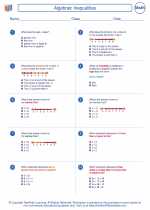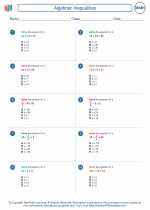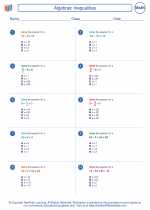Algebraic Inequalities -> real numbers
Real Numbers
Real numbers include all the rational and irrational numbers. They can be represented on the number line and are used in various mathematical calculations and operations.
Types of Real Numbers
- Rational Numbers: These are numbers that can be expressed as a fraction of two integers, where the denominator is not equal to zero. Examples include 1/2, 3/4, 5, and -2.
- Irrational Numbers: These are numbers that cannot be expressed as a fraction, and their decimal expansions are non-repeating and non-terminating. Examples include √2, π, and e.
- Integers: These are whole numbers, including positive and negative numbers, as well as zero. Examples include -3, -2, -1, 0, 1, 2, 3.
- Natural Numbers: Also known as counting numbers, these are positive integers starting from 1. Examples include 1, 2, 3, 4, 5.
- Whole Numbers: These are non-negative integers, including zero. Examples include 0, 1, 2, 3, 4.
Properties of Real Numbers
Real numbers have certain properties that govern their behavior in mathematical operations. These properties include:
- Commutative Property: a + b = b + a and a * b = b * a
- Associative Property: (a + b) + c = a + (b + c) and (a * b) * c = a * (b * c)
- Distributive Property: a * (b + c) = a * b + a * c
- Identity Property: a + 0 = a and a * 1 = a
- Inverse Property: a + (-a) = 0 and a * (1/a) = 1
Study Guide
When studying real numbers, it's important to understand the classification of real numbers, their properties, and how they are used in mathematical operations. Here are some key points to focus on:
- Learn to classify numbers as rational, irrational, integers, natural, or whole numbers.
- Understand the properties of real numbers and how they apply to addition, subtraction, multiplication, and division.
- Practice representing real numbers on the number line and comparing their magnitudes.
- Work on solving problems involving real numbers, including word problems and mathematical expressions.
- Explore real-world applications of real numbers in various fields such as science, finance, and engineering.
By mastering the properties and classifications of real numbers, you will have a solid foundation for more advanced mathematical concepts and applications.
[Real Numbers] Related Worksheets and Study Guides:
.◂Math Worksheets and Study Guides Seventh Grade. Algebraic Inequalities
Study Guide Algebraic Inequalities
Algebraic Inequalities  Worksheet/Answer key
Worksheet/Answer key Algebraic Inequalities
Algebraic Inequalities  Worksheet/Answer key
Worksheet/Answer key Algebraic Inequalities
Algebraic Inequalities  Worksheet/Answer key
Worksheet/Answer key Algebraic Inequalities
Algebraic Inequalities 

 Worksheet/Answer key
Worksheet/Answer key
 Worksheet/Answer key
Worksheet/Answer key
 Worksheet/Answer key
Worksheet/Answer key

The resources above cover the following skills:
Algebra (NCTM)
Represent and analyze mathematical situations and structures using algebraic symbols.
Use symbolic algebra to represent situations and to solve problems, especially those that involve linear relationships.